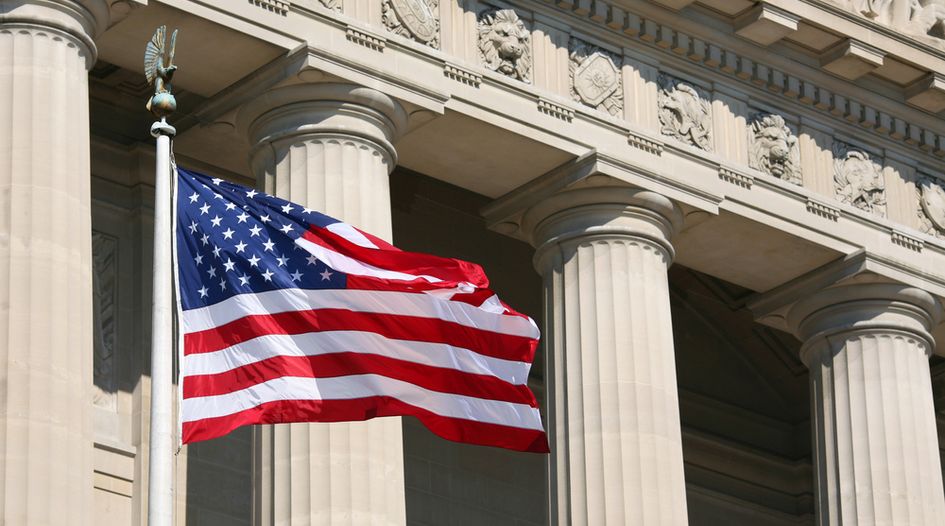United States: Best practices for filing and prosecuting trademarks before the USPTO

This is an Insight article, written by a selected partner as part of WTR's co-published content. Read more on Insight
In summary
This article summarises general principles of trademark prosecution in the United States.
Discussion points
- The types of trademarks that can and cannot be registered
- Common law trademark rights
- Non-traditional trademarks
- Opposition to trademarks and petitions for cancellation
- Transferring ownership of trademarks
- Best practices for trademark licensing and assignments of trademarks
- Trademark need-to-knows in the United States
Referenced in this article
- The Trademark Manual of Examining Procedure
- Wal-Mart Stores, Inc v Samara Bros
- Seabrook Foods, Inc v Bar-Well Foods, Ltd
What can be registered?
In the United States, a trademark[1] is a device that is used to indicate the source of goods or services to which it is applied, and gives the owner the exclusive right to use the mark on those goods or services. As such, a registered trademark does not give the owner exclusive rights to prevent anyone from using the mark in any context. Rather, it gives the owner protection in connection with the specific goods and services with which the mark is registered throughout the United States and, in some instances, with those that are considered related or in the natural zone of expansion.
In addition to those rights, a trademark registration in the United States provides the owner with the following rights and privileges:
- the right to use the ® symbol to indicate registration with the United States Patent and Trademark Office (USPTO);
- listing of the trademark in the USPTO database of registered marks, which provides notice to anyone searching for the same or a similar mark;
- presumptive nationwide rights, which may ease the burden in federal litigation;
- the ability to use the registration as proof of ownership in any trademark-related disputes; and
- the right to register the trademark with US Customs and Border Patrol to prevent counterfeit goods from entering the country.
Almost anything can be a trademark if it is used to indicate the source of goods or services. For example, trademarks can range from words, images and designs to sounds, smells, colours, shapes of goods and even the trade dress of a restaurant or other establishment. While all of these can be registered with the USPTO, some of them are held to a heightened level of scrutiny and require a showing of secondary meaning.
What cannot be registered?
While the format of a trademark can vary, there are some restrictions as to what can be registered. Words, images or designs that are generic cannot be registered as trademarks. Marks are considered to be generic when the term is one that the purchasing public considers to be the common or class name for the goods or services.[2] For example, the word ‘book’ for books is generic and cannot function as a trademark for those products (although it might be protectable if used for a completely unrelated item, such as the name of a restaurant). Similarly, sounds, smells, colours or shapes that are functional cannot be registered.
Other trademarks may be registrable only under certain circumstances. Specifically, marks that are descriptive of an ingredient, quality, characteristic, function, feature or purpose of the goods or services, or geographically descriptive of the place where the goods or services are produced, are difficult to register on the Principal Register.[3] Some marks that would be refused registration on the Principal Register may be registered on the Supplemental Register. For example, trademarks that are merely descriptive or primarily merely a surname may be amended to the Supplemental Register and given the opportunity to acquire distinctiveness.
In the United States there are two registers: the Principal Register and the Supplemental Register. The Principal Register is for trademarks that are inherently distinctive and capable of functioning as an indicator of the source of goods and services. The Supplemental Register is a secondary register for trademarks that contain some descriptive or non-distinctive element and are not inherently capable of indicating source, but may become capable over time. A mark may only be registered on the Supplemental Register if it is in use in US commerce (or based on a home country registration if owned by a foreign applicant).
Marks that are registered on the Supplemental Register do not enjoy the same rights and privileges as those on the Principal Register. A mark registered on the Supplemental Register may use the ® symbol and be used as constructive evidence and notice of ownership of the mark and priority use. However, registration on the Supplemental Register is not presumptive evidence of the validity of the registration, nor of the ownership of the mark or the exclusive right to use it in the United States.
Marks that cannot be registered on either the Principal Register or the Supplemental Register include:
- marks that are likely to be confused with prior registered marks;
- marks containing deceptive matter and matter that may falsely suggest a connection with persons living or dead, institutions, beliefs or national symbols;
- marks that lead consumers to believe goods or services originate in a place where they do not;
- flags, coats of arms or other insignia of the United States, a state or municipality, or a foreign nation;
- names, portraits, or signatures of particular living individuals without their consent, or deceased US presidents without the consent of their living spouse; and
- titles of single creative works (eg, titles of books, albums and songs)
Common law trademark rights
In the United States, common law trademark rights are unregistered rights that are based on the use of a trademark in commerce in a particular geographic area. Common law trademark rights can be enforced only in the geographic area in which the trademark is used.
Common law trademark rights grant the owner some of, but not all, the rights granted in a federal registration. They include the right to use the trademark in connection with the goods and services in that geographic area (but not necessarily the right to expand beyond that), as well as the right to enforce those rights in both the Trademark Trial and Appeal Board (TTAB) and federal or state court.
Non-traditional trademarks
Non-traditional trademarks such as sound, scent, colour and trade dress are held to higher standards than traditional trademarks. Like traditional trademarks, non-traditional marks must be capable of indicating the source of the goods and services and must not consist of material that is descriptive of or generic for the goods or services. However, non-traditional marks are not protectable to the extent they provide a functional purpose for the goods or services.[4]
Aside from those differences, the procedure for prosecuting non-traditional marks is substantially the same as for traditional trademarks.
To be registrable, non-traditional trademarks cannot be functional and must have acquired distinctiveness. Both elements must be met: if the applied-for mark is functional but has acquired distinctiveness, this is not sufficient to obtain registration. Similarly, if the mark is not functional but has only been used minimally for two years, registration on the Principal Register may be difficult.
The most common type of non-traditional trademark is trade dress. The Supreme Court has distinguished between two types of trade dress – product design and product packaging.[5] Product design trade dress cannot be inherently distinctive and, therefore, is registrable on the Principal Register only with a claim of acquired distinctiveness.[6] If the product design has not obtained acquired distinctiveness, it may be registered on the Supplemental Register.[7]
The bar for establishing distinctiveness for a trade dress application for the Principal Register is high, and a mere statement of five years’ use (which is the standard for traditional marks) is generally not sufficient. Additionally, when providing evidence of acquired distinctiveness, it should show use of the product design trade dress alone, rather than together with other marks, in order to give greater weight to the evidence of sales and advertising figures.[8] The applicant must be able to show that consumers would recognise the specific configuration of the trade dress mark, and not the goods or services in general.
Meanwhile, product packaging trade dress can be inherently distinctive. When determining if a proposed product packaging trade dress is inherently distinctive, the USPTO considers whether the:
- proposed mark is a ‘common’ basic shape or design;
- mark is unique or unusual in the proposed field;
- proposed mark is a mere refinement of a commonly adopted and well-known form of ornamentation for a particular class of goods viewed by the public as a dress ornamentation for the goods; or
- proposed mark is capable of creating a commercial impression distinct from the accompanying words.[9]
Any one of these factors by itself may be determinative as to whether a mark is inherently distinctive.[10]
If the non-functional product packaging, product design or other trade dress mark has not acquired distinctiveness, it may be registered on the Supplemental Register.
How are oppositions handled?
All applications on the Principal Register are published in the Official Gazette and are open for opposition by any third party. An opposition, or a request for an extension of time, must be filed with the TTAB within 30 days of publication of the mark. A 30-day extension of time is granted without cause (and at no cost); an additional 60-day extension of time is available for good cause (and upon payment of a fee). A further 60-day extension of time (for a total of 180 days) may be granted if consent from the applicant is obtained (and upon payment of an additional fee). The most common grounds on which an additional 60-day extension is granted are if more time is needed to investigate the claim, seek counsel or negotiate a settlement.
If an opposition is not filed at the end of this period or the appropriate extension of time was not initially requested, or both, a potential opposer must wait until the application matures to registration to file a petition to cancel. If an application is based on intent to use and an applicant takes advantage of all five extensions of time to show use, a potential opposer may have to wait three years to take action against a mark.
The notice of opposition must be filed together with the required fee, which is currently US$600 per class. It is possible to oppose only some of the classes covered by an application; not all classes have to be opposed.
Possible grounds for opposition include:
- priority or likelihood of confusion;
- descriptiveness; and
- genericness.
While the initial costs to file an opposition (or cancellation) may be minimal, the entire proceeding could take years and cost hundreds of thousands of dollars, depending on how extensive discovery is, whether a consumer survey is obtained and whether the action goes through to trial. Much like regular litigation, it is difficult to estimate the cost of a proceeding because of the many different factors involved.
How are cancellations handled?
A petition for cancellation can be filed at any time after a registration issues; however, some grounds for cancellation are not available once a registration has been registered for five years. The petition for cancellation must be filed together with the required fee, which is currently US$600 per class.
Common grounds on which a petition to cancel can be filed at any time include the following:
- the mark has been abandoned;
- the registration was obtained by fraud;
- the mark is generic; and
- the mark is geographically deceptive.
The grounds most notably missing from this list are likelihood of confusion or priority and descriptiveness. They are missing because marks that have been registered for five years on the Principal Register and used continuously during that time are afforded additional rights by virtue of their incontestable status; in a petition for cancellation, third parties cannot claim prior use of a mark (and therefore superior rights) against a registration that is incontestable.
Assuming the opposition or petition for cancellation has been filed in a timely manner and properly served, and the appropriate filing fees have been paid, the TTAB will institute the proceeding and issue a scheduling order outlining the deadlines for the proceeding.
Ultimately, if a decision is rendered, it determines only whether that particular mark is registrable; it does not have any bearing on whether a party can use a mark.
What are the pendency levels for the past 12 months?
The time between filing a new trademark application with the USPTO and first examination on average is 8.3 months.[11] The average time between filing a new application and that application registering is 14.6 months.[12] This assumes that the application does not face any substantive issues, multiple office actions or oppositions by third parties, which can increase the timeline to registration.
How to transfer ownership of trademarks
During the course of a trademark’s life, a number of different occurrences can affect title. For example, like other property, trademarks can be sold or transferred. Similarly, security interests can be granted to IP rights. Or perhaps a change of name or merger has affected the structure or name of the owner of record. Some occurrences affect title immediately (like an assignment); others simply preserve a party’s interest (such as a security interest). Most transfers affecting title can be recorded with the USPTO; some must be recorded within a certain amount of time to preserve rights against third parties.
The USPTO recently updated its process for recording assignments and other documents relating to ownership, to streamline and modernise the process.[13] The aesthetic of the platform has changed, though the key functionalities remain similar to the old system.
Licensing and assignment best practice
Licensing
Many trademark owners license their trademarks to other parties to develop the brand in specific areas where it does not traditionally operate. For example, the owner of a trademark most known for clothing might license another to use the mark on accessories, because the owner does not have the capability to develop and make the accessories. Other trademark owners may have a corporate structure such that one entity owns the trademark for tax purposes but allows another related entity to use it. If done with a proper licence, these types of arrangements can increase the value of the brand and strengthen the trademark owner’s rights; however, if done improperly, they could denigrate the value of the trademark or create a situation in which the trademark owner has legally abandoned the mark.
A key point in US licensing is to avoid ‘naked’ licensing. This is when a trademark owner allows another party to use its trademarks without sufficient control. The amount of control required to avoid naked licensing depends on the context. Elements that can point toward retention of control include:
- a written licence agreement;
- the licensor’s periodic review of licensed goods or services;
- appointment of a quality control officer; and
- establishment of trademark use guidelines.
Assignment
An assignment transfers all right, title and interest in a trademark from one party to another. To be a valid assignment, an assignment must transfer the goodwill associated with the trademark.
An assignment cannot be terminated; once the assignment has been executed, the mark has been sold and transferred to the new owner. While the assignor may attempt to preserve certain rights contractually (ie, if the assignee does not sell US$1 million worth of widgets in a five-year period, the mark reverts back to the assignor), courts may not view this as an assignment but rather as a licence; if viewed as a licence, it may be viewed as a naked licence, thereby calling into question the assignor’s rights in the mark.
Applicants should be aware that in the United States, the law prohibits the transfer of intent to use trademark applications. The exception to this rule is when the purchaser is the successor to the business to which the trademark pertains, and that business is ongoing and existing.
What are the five key need-to-knows for the jurisdiction?
- Search before filing to see if anyone else is using or has registered the mark in question or one that is substantially similar to the mark: searching to determine if anyone else is using the mark in connection with proposed goods and services can save time, money and frustration. If the proposed mark is not available, a new one can be picked and cleared before the product or services are launched, and the application process will likely be much smoother.
- USPTO’s new trademark search platform: the USPTO recently launched a new trademark search platform to replace the prior one. The new system was designed to be more user-friendly, though as a caveat the USPTO appears to still be working on resolving functionality issues because the new search platform sometimes yields incomplete results and, in a small number of cases, lists incorrect application and registration statuses.[14]
- File early: current examination wait times can be frustrating to trademark owners looking for quick answers; it is recommended to file new applications early in the branding and product launch process. Additionally, filing early preserves rights to the mark even if the client is a few years from market.
- Tailor your goods and services, especially for registrations based on home country registrations: there has been an increase in non-use challenges brought by third parties against these types of registrations (both at the TTAB and via the newly created expungement proceedings). Instead of filing to cover a broad range of goods and services, consider tailoring your goods and services and filing for those goods and services that you actually have an intent to use in the United States.
Post-registration audits: when filing maintenance or renewal documents, trademark owners should take a careful look at their goods and services and proactively delete any items that are no longer in use. There has been an increase in post-registration audits, and proactively deleting goods and services can save costs later.
Endnotes
[1] The term ‘service mark’ is often used to refer to use in connection with services instead of goods. For convenience, we’ll use ‘trademark’ to refer to both throughout this article.
[2] TMEP section 1209.01(c).
[3] TMEP section 1209.01(b).
[4] TMEP section 1202.02(a)(viii).
[5] Wal-Mart Stores, Inc v Samara Bros, 529 US 205 USPQ2d 1065, 1069 (2000).
[6] TMEP 1202.02(b)(i).
[7] id.
[8] id.
[9] Seabrook Foods, Inc v Bar-Well Foods, Ltd, 568 F.2d 1342, 1344, 196 USPQ 289, 291 (CCPA 1977).
[10] TMEP section 1202.02(b)(ii).
[12] id.


